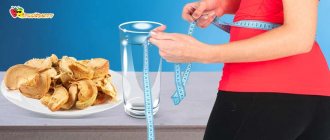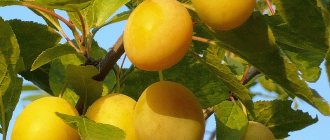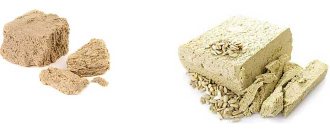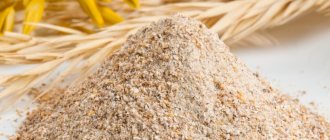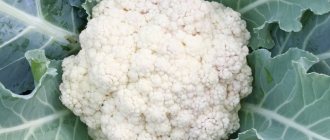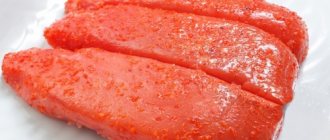Calorie content of Kohlrabi. Chemical composition and nutritional value.
Nutritional value and chemical composition of Kohlrabi.
| Nutrient | Quantity | Norm** | % of the norm in 100 g | % of the norm in 100 kcal | 100% normal |
| Calorie content | 44 kcal | 1684 kcal | 2.6% | 5.9% | 3827 g |
| Squirrels | 2.8 g | 76 g | 3.7% | 8.4% | 2714 g |
| Fats | 0.1 g | 56 g | 0.2% | 0.5% | 56000 g |
| Carbohydrates | 7.9 g | 219 g | 3.6% | 8.2% | 2772 g |
| Organic acids | 0.1 g | ||||
| Alimentary fiber | 1.7 g | 20 g | 8.5% | 19.3% | 1176 g |
| Water | 86.2 g | 2273 g | 3.8% | 8.6% | 2637 g |
| Ash | 1.2 g | ||||
| Vitamins | |||||
| Vitamin A, RE | 17 mcg | 900 mcg | 1.9% | 4.3% | 5294 g |
| beta carotene | 0.1 mg | 5 mg | 2% | 4.5% | 5000 g |
| Vitamin B1, thiamine | 0.06 mg | 1.5 mg | 4% | 9.1% | 2500 g |
| Vitamin B2, riboflavin | 0.05 mg | 1.8 mg | 2.8% | 6.4% | 3600 g |
| Vitamin B4, choline | 12.3 mg | 500 mg | 2.5% | 5.7% | 4065 g |
| Vitamin B5, pantothenic | 0.1 mg | 5 mg | 2% | 4.5% | 5000 g |
| Vitamin B6, pyridoxine | 0.17 mg | 2 mg | 8.5% | 19.3% | 1176 g |
| Vitamin B9, folates | 18 mcg | 400 mcg | 4.5% | 10.2% | 2222 g |
| Vitamin C, ascorbic acid | 50 mg | 90 mg | 55.6% | 126.4% | 180 g |
| Vitamin E, alpha tocopherol, TE | 0.2 mg | 15 mg | 1.3% | 3% | 7500 g |
| Vitamin K, phylloquinone | 0.1 mcg | 120 mcg | 0.1% | 0.2% | 120000 g |
| Vitamin RR, NE | 1.2 mg | 20 mg | 6% | 13.6% | 1667 g |
| Niacin | 0.9 mg | ||||
| Macronutrients | |||||
| Potassium, K | 370 mg | 2500 mg | 14.8% | 33.6% | 676 g |
| Calcium, Ca | 46 mg | 1000 mg | 4.6% | 10.5% | 2174 g |
| Silicon, Si | 71 mg | 30 mg | 236.7% | 538% | 42 g |
| Magnesium, Mg | 30 mg | 400 mg | 7.5% | 17% | 1333 g |
| Sodium, Na | 10 mg | 1300 mg | 0.8% | 1.8% | 13000 g |
| Phosphorus, Ph | 50 mg | 800 mg | 6.3% | 14.3% | 1600 g |
| Microelements | |||||
| Aluminium, Al | 815 mcg | ||||
| Iron, Fe | 0.6 mg | 18 mg | 3.3% | 7.5% | 3000 g |
| Selenium, Se | 0.7 mcg | 55 mcg | 1.3% | 3% | 7857 g |
| Digestible carbohydrates | |||||
| Starch and dextrins | 0.5 g | ||||
| Mono- and disaccharides (sugars) | 7.4 g | max 100 g | |||
| Saturated fatty acids | |||||
| Saturated fatty acids | 0.013 g | max 18.7 g | |||
| Polyunsaturated fatty acids | |||||
| Omega-3 fatty acids | 0.026 g | from 0.9 to 3.7 g | 2.9% | 6.6% | |
| Omega-6 fatty acids | 0.02 g | from 4.7 to 16.8 g | 0.4% | 0.9% |
The energy value of Kohlrabi is 44 kcal.
Main source: Skurikhin I.M. and others. Chemical composition of food products. Read more.
** This table shows the average levels of vitamins and minerals for an adult. If you want to know the norms taking into account your gender, age and other factors, then use the “My Healthy Diet” application.
How many calories are in sauerkraut
This type of vegetable, prepared for future use, has long been revered in Rus'. It is especially useful during the period of vitamin deficiencies in winter and spring. Moreover, not only the sour crispy leaves are useful, but also the brine itself - it is also rich in vitamins and minerals, and its calorie content is almost zero.
To get more benefits from sauerkraut, it is recommended to salt it whole or in halves. In cut leaves, the amount of vitamins is reduced by half, since a significant part of them goes into brine or is destroyed.
The calorie content of sauerkraut is 27 kcal/100 g.
You can ferment not only white cabbage, but also Chinese cabbage. This dish is popular in Korea and even has a special name in Korean – “kimchi”. In terms of its energy and nutritional value, it is not inferior to traditional pickled white cabbage.
In addition to the fact that sauerkraut is a desirable product for those who want to lose weight, it has a number of associated beneficial properties. Regular consumption of this low-calorie product increases the chances of:
- strengthen the body's immunity,
- increase stress resistance,
- activate metabolism,
- increase the number of red blood cells,
- rejuvenate the body,
- lower cholesterol levels,
- activate intestinal function,
- improve intestinal microflora,
- strengthen the heart muscle.
But, despite the pronounced beneficial properties and low calorie content, those who suffer from high blood pressure and hypersecretion of gastric juice should not get carried away with sauerkraut. The list of contraindications also includes kidney and pancreas diseases, as well as the presence of gallstones.
What are the benefits of Kohlrabi?
- Vitamin C
is involved in redox reactions, the functioning of the immune system, and promotes the absorption of iron. Deficiency leads to loose and bleeding gums, nosebleeds due to increased permeability and fragility of blood capillaries. - Potassium
is the main intracellular ion that takes part in the regulation of water, acid and electrolyte balance, and is involved in the processes of conducting nerve impulses and regulating blood pressure. - Silicon
is included as a structural component in glycosaminoglycans and stimulates collagen synthesis.
You can see a complete guide to the healthiest foods in the “My Healthy Diet” app.
- home
- Product composition
- Composition vegetables and herbs
- Chemical composition of "Kolrabi"
Tags:
Kohlrabi calorie content 44 kcal, chemical composition, nutritional value, vitamins, minerals, benefits of Kohlrabi, calories, nutrients, beneficial properties of Kohlrabi
Energy value, or calorie content
- this is the amount of energy released in the human body from food during the digestion process. The energy value of the product is measured in kilocalories (kcal) or kilojoules (kJ) per 100 grams. product. The kilocalorie used to measure the energy value of food is also called a food calorie, so when caloric content is reported in (kilo)calories, the prefix kilo is often omitted. You can see detailed energy value tables for Russian products here.
The nutritional value
— content of carbohydrates, fats and proteins in the product.
Nutritional value of food product
- a set of properties of a food product, in the presence of which the physiological needs of a person for the necessary substances and energy are satisfied.
Vitamins
, organic substances required in small quantities in the diet of both humans and most vertebrates. Vitamin synthesis is usually carried out by plants, not animals. A person's daily requirement for vitamins is only a few milligrams or micrograms. Unlike inorganic substances, vitamins are destroyed by strong heat. Many vitamins are unstable and are “lost” during cooking or food processing.
Can it harm
Kohlrabi, like other cabbage varieties, has incredible health benefits. But it is worth noting that it can still cause harm. Therefore, you need to know in which cases it is better to stop using it or reduce the intake rate. So, it is not recommended to eat the vegetable:
- In the presence of pancreatitis.
- If you suffer from high stomach acidity. Reception can increase it even more.
- In case of individual intolerance (allergy).
- For those who have diabetes. The vegetable contains a lot of sugar.
- In large quantities it can lead to poisoning, as it has the ability to accumulate nitrates.
- For those who see on diets. Cabbage has the ability to increase appetite. There is no need to refuse at all. Its use must be strictly controlled.
- You should not drink kohlrabi juice if you have gastritis or ulcers.
- The vegetable is grown in greenhouses. In this case, it is better not to even buy it. If cabbage does end up on your table, then consumption should be reduced to a minimum. The fact is that when grown, greenhouse vegetables contain additives, nitrates, nitrites and other harmful substances, which, in turn, block the entry of oxygen into the cells of our body.
But, in any case, despite the negative impact, first of all, consult a doctor and get advice. After all, kohlrabi is a very healthy product, and its use will bring many benefits. Of course, except in cases where it is completely prohibited.
In pursuit of the beneficial properties of kohlrabi cabbage, you should also be aware of some of its negative properties that can negate the resulting therapeutic effect. For example, people suffering from increased gas formation should combine the consumption of kohlrabi cabbage with rice or beets. For gastritis and other gastrointestinal diseases of the hyperacid type, kohlrabi cabbage should be avoided or consumed together with foods that neutralize its acid-forming properties. So, you can drink kohlrabi juice mixed with carrot juice.
Like many stem vegetables, kohlrabi has the ability to draw a considerable amount of nitrates from the soil, which, when accumulated in the body, provoke cancer. Therefore, if kohlrabi is not grown on your own plot, it is best to purchase it not in supermarkets, but in markets from private summer residents who most often do not use agricultural chemicals on their plots.
As for an allergic reaction to cabbage, this is a fairly rare occurrence. However, if an allergy to weed pollen (for example, ragweed) is detected, then it can also cross-react to cabbage. Therefore, if you find kohlrabi in your diet for the first time, you should be careful when consuming it for the first time and listen to the body’s response.
Kohlrabi cabbage
Kohlrabi is a biennial herbaceous food plant, a botanical variety of white cabbage.
Unlike other cabbages, they eat not the leaves, but the thickened lower part of the stem - the stem fruit. Kohlrabi is widespread in Western Europe, the USA, Canada and especially in the middle and northern latitudes. It is resistant to adverse weather conditions, so it is grown even in the Far North, Kamchatka and Sakhalin.
The edible part of kohlrabi is the stem, which in the above-ground part takes on a spherical or turnip-like shape.
The taste of kohlrabi cabbage is juicy, sweetish, without the spiciness characteristic of white cabbage. The overgrown stem tastes like a cabbage stump, but kohlrabi is much tastier and juicier.
Calorie content of kohlrabi cabbage
The calorie content of kohlrabi cabbage is 42 kcal per 100 grams of product.
Composition of kohlrabi cabbage
Kohlrabi cabbage contains a high content of vitamin C, as well as vitamins such as A, B, B2, PP. In addition, the product is rich in valuable mineral salts, as well as magnesium, calcium, phosphorus, potassium, iron and cobalt. Kohlrabi contains enzymes and large quantities of vegetable proteins and fiber (calorifier). The pulp of this cabbage is rich in fructose, glucose, and contains sulfur compounds, so it is a fairly valuable dietary product. The high content of vitamin C in kohlrabi cabbage explains its other name - “northern lemon”.
Useful properties of kohlrabi cabbage
Undoubtedly, kohlrabi cabbage is very healthy. It is especially recommended for use by children and pregnant women. Eating kohlrabi has a beneficial effect on metabolism and the functioning of the digestive system, especially the liver, gall bladder, and gastrointestinal tract. The high potassium content in kohlrabi promotes the removal of fluid from the body, and the presence of fiber prevents the deposition of cholesterol and plays an important role in the prevention and treatment of atherosclerosis.
Modern medical research has proven that the presence of kohlrabi cabbage in the menu is an excellent prevention of colon and rectal cancer, which is due to the fact that this product contains sulfur-containing substances.
The healing qualities of kohlrabi are also used in folk medicine. A decoction of the stem fruit and tops of this vegetable is used in the treatment of pulmonary tuberculosis and asthma.
The above beneficial properties make kohlrabi cabbage an important component in the menu of people who want to eat healthy with maximum health benefits.
Kohlrabi in cooking
Raw fresh stem fruits are eaten, as well as young leaves of kohlrabi cabbage. Salads made from raw kohlrabi are especially tasty, thanks to their juicy and delicate taste. However, kohlrabi is also consumed boiled and stewed, like regular white cabbage. If you grate kohlrabi on a coarse grater and then season it with vegetable oil, its taste will be slightly similar to the taste of radish, only much more delicate. When heat treating kohlrabi, it is better to cut it into small cubes the size of a pea.
Kohlrabi cabbage is used to prepare stews, pancakes, and vegetable soup. It can be stuffed by removing the pulp from the core of the stem fruit and putting in a filling of finely chopped vegetables or meat (calorizator). Kohlrabi cabbage can not only be stuffed, but also baked, fried in breadcrumbs, marinated, and boiled kohlrabi is served hot with the addition of cheese sauce. To emphasize and enhance the special taste of this vegetable, it is recommended to add lime juice or soy sauce to dishes with fresh cabbage.
Shrimp, fish, chicken, carrots, cucumbers and peanuts go well with kohlrabi cabbage.
What does it help to heal from?
The benefits of kohlrabi for the body are invaluable. It can have a very positive effect on the body.
- Has a gentle diuretic effect. This allows a person to get rid of swelling and remove excess fluid.
- Able to reduce blood pressure and maintain normal. Therefore, the vegetable is very useful for hypertensive patients.
- The fiber content and other quickly digestible fibers help remove cholesterol from the blood.
- It is an excellent preventative against atherosclerosis. The beneficial substances in the composition gently open blood vessels and increase blood circulation. Therefore, the risk of blood clots is significantly reduced.
- It fights constipation well, as the vegetable stimulates the intestines to quickly absorb food.
- Has the property of blocking the formation of new capillaries. Thus, it can be a good remedy against bowel cancer, as it does not allow malignant cells to multiply.
- Used in the treatment of tuberculosis. This product is very easy to prepare. You need to mix 25 grams of honey and 100 grams of kohlrabi juice. Drink this drink three times a day an hour before meals. Also, this variety of cabbage is often replaced with white cabbage.
- Useful to add during diet. Kohlrabi has the ability to control the transformation of carbohydrates into energy rather than fat. The vegetable also contains very few calories. Nutritionists recommend it for obese people.
- Eating kohlrabi is especially beneficial for people who have problems with low stomach acidity and, because of this, gastritis. Cabbage helps increase acidity to normal levels and eliminates inflammation in the stomach.
- It is an excellent way to cleanse the body of toxins, toxins and other harmful substances.
- Consumption helps improve the condition of the skin, hair, nails and teeth. The antioxidants contained in the composition cleanse pores, make the skin more elastic and relieve inflammation.
- Often used in the treatment of diseases of the respiratory system. The remedies help cope with bronchitis and asthma.
Kohlrabi cabbage
Kohlrabi cabbage is a so-called stem fruit. The core of this fruit is tender and juicy, very pleasant to the taste, somewhat reminiscent of a cabbage stalk. Northern Europe is considered the birthplace of kohlrabi. The name translated from German is interpreted as “cabbage turnip”. The first mention of this vegetable was recorded in 1554, and literally a century later, kohlrabi spread throughout almost all of Europe, right up to the Mediterranean.
This vegetable is very unpretentious, is resistant to pests and diseases and grows successfully even in northern regions, thanks to its rapid ripening.
Calorie content of kohlrabi
The calorie content of kohlrabi cabbage is 42 kcal per 100 g of product. It is indicated for use by overweight people.
Nutritional value per 100 grams:
| Proteins, g | Fats, gr | Carbohydrates, g | Ash, gr | Water, g | Calorie content, kcal |
| 2,8 | 0,1 | 8 | 1,2 | 86 | 42 |
Useful properties of kohlrabi cabbage
Kohlrabi contains a large amount of vitamin C, it is not without reason that it is called lemon from the garden,
as well as vitamins A, B, PP, B2. This vegetable is rich in large amounts of vegetable proteins, carbohydrates, mineral salts, calcium, potassium, phosphorus, magnesium, carotene, pantothenic acid, cobalt and iron. Tender and juicy stem fruits with white pulp contain glucose and fructose, which are easily absorbed by the body and give a feeling of satiety.
In terms of overall vitamin absorption, kohlrabi is superior to apples.
It is a means of preventing all kinds of infectious diseases. Eating kohlrabi helps normalize metabolism, so its use is indicated for those who want not just to lose weight, but to consolidate the result for a long time.


